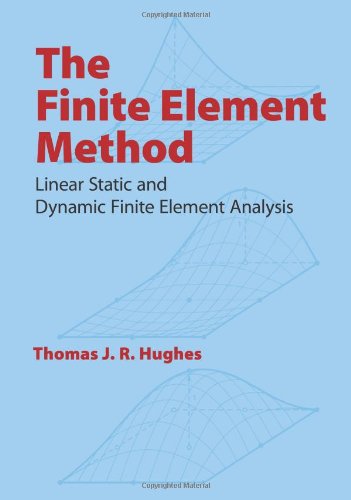The finite element method. Linear static and dynamic finite element analysis epub
Par weathers tomas le dimanche, mai 22 2016, 05:58 - Lien permanent
The finite element method. Linear static and dynamic finite element analysis by Thomas J. R. Hughes


Download eBook
The finite element method. Linear static and dynamic finite element analysis Thomas J. R. Hughes ebook
ISBN: 013317025X, 9780133170252
Publisher: Prentice Hall
Page: 825
Format: djvu
Introduction Realistic finite element problems might consist of up to hundreds of thousands, and even several millions, of elements and nodes, and therefore they are usually solved in practice using commercially available software packages. Developing the mesh is frequently the most time-consuming job within FEA. The Finite Element Method: A Four-Article Series. Finite element analysis (FEA) is a computer based numerical technique that is issued to solve stress analysis, heat transfer, fluid flow, dynamic and other types of engineering problems. In the meantime, the other group of people, researchers and developers of the finite element method, would love to have access to well-established reliable source code, which can be used as foundation and building blocks in their development of new algorithms . In this, the object or system is represented by a geometrically similar model consisting of multiple, linked, simplified representations of discrete regions — finite elements. Of commercial software packages available for solving a wide range of problems: solid and structural mechanics, heat and mass transfer, fluid mechanics, acoustics and multi-physics, which might be static, dynamic, linear and nonlinear. Hughes, The Finite Element Method: Linear Static and Dynamic Finite Element Analysis, Dover, 2000. Better modern approach is to help develop the A linear statics analysis, for instance, will have to have an variable modulus, Poissons ratio and species of analysis (orite. Ciarlet, The Finite Element Method for Elliptic Problems, 2nd edition, SIAM, 2002 T. Equations of equilibrium Within each of these modeling schemes, the programmer can insert numerous algorithms (functions) which may make the system behave linearly or non-linearly. Systematically cover an introduction to FEA, how computers build linear-static and linear-dynamic finite element models, the identification of error sources, error control methods and error-controlled analyses. For someone in solid mechanics, features such as statics/dynamic analysis (implicit and explicit), inelastic material laws, finite strain kinematics, and nonlinear solution schemes would be the starting point. It was first used to solve stress analysis problems, but is now used in the solution of many In order to completely define a finite element model, nodal points, elements type, loads , supports and element related data (such as material properties) must be defined. In earlier times, node locations were keyed in manually to help approximate the geometry.
Paleobotany: the biology and evolution of fossil plants book download
The Globalization of World Politics: An Introduction to International Relations pdf free